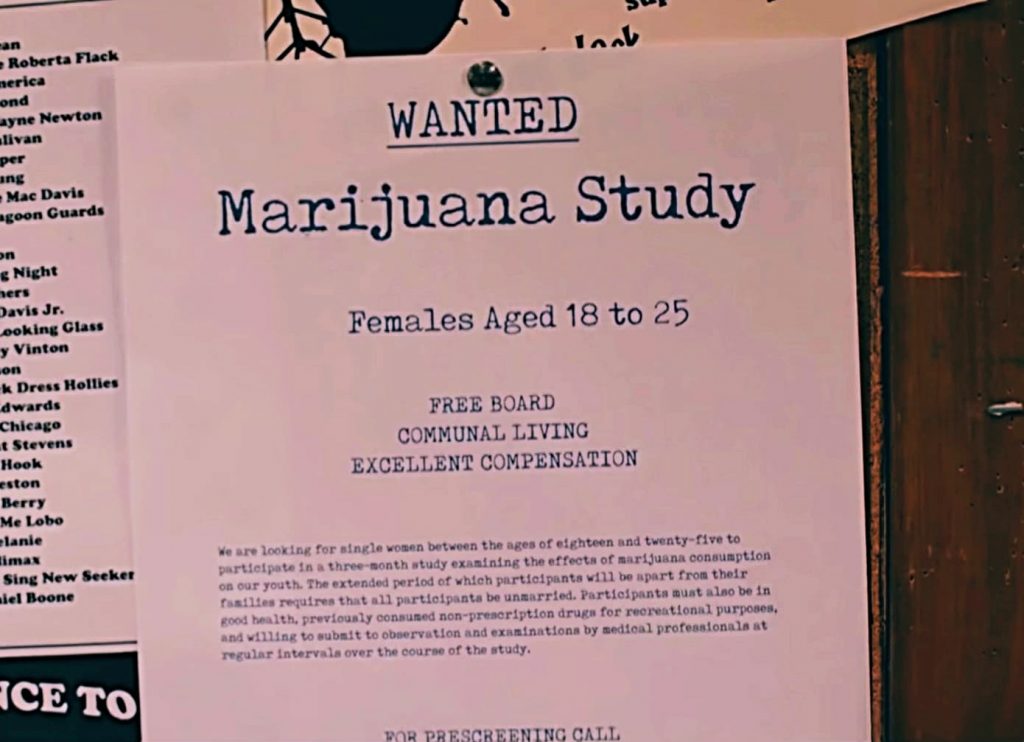What do you get when you combine the progressive atmosphere of the 1970s, clashing cultural views and restrictions imposed on women, and an extensive and very secretive government study on cannabis with results that mysteriously vanished? You get one hell of a marijuana conspiracy, that’s what.
Who doesn’t love a good conspiracy theory right? I mean, the entire history of marijuana in the western world is shrouded in conspiracy. A healing plant, one that can possibly heal cancer, with no real side effects… and it’s banned for decades all to fulfil the agendas of some greedy politicians and business owners. Nothing really screams machination louder than that.
Limited time offer: Delta 8 THC vape carts – only $10/cart
Even in stoner legends we hear the tales of “secret government facilities” running experiments on unsuspecting potheads. You know, the stories of your old college roommate’s second cousin who participated in the one, he was locked in a room decked out with psychedelic décor while nerdy scientists watched him smoke unbelievably dank government super-weed. He went home stoned, thousands of dollars richer, and with a seriously interesting story to tell during the next smoke sesh.
On the surface, the real-life version of these government funded cannabis studies weren’t much different. Participants were housed in a research facility that was arranged to feel somewhat leisurely, and they got paid good money to smoke extremely potent government pot. But what exactly was going on behind the scenes? Surely they weren’t just lounging around, watching movies, eating snacks, and smoking good weed for months on end? What was the objective here? What was the Canadian government trying to accomplish and learn with these studies? To this day, the answers to these and many other questions remain uncertain.
As study participant Sharon Purdy mentions, “It was such an upside-down set of circumstances. Here you were under the best medical supervision available with the best pot available, kind of, doing something illegal legally.”
To learn more about cannabis, Delta 8, and for exclusive deals on flowers and other products, make sure to subscribe to The Delta 8 Weekly Newsletter
About ‘The Marijuana Conspiracy‘
The movie, titled The Marijuana Conspiracy – set to debut for streaming on 4/20, tells the story of this dubious study from the perspective of the women involved in it. The idea for the film came from none other than a study participant herself, Doreen Brown. Many years after the experiment ended, Brown starting sharing her story more publicly which eventually led to a full investigative report conducted by Diana Zlomislic from the Toronto Star in 2013.

The Marijuana Conspiracy – Streaming April 20, 2021!
The film uncovers the motivations of those involved in conducting the experiment such as the funders, designers, and implementers; as well as the experiences and backgrounds of the test subjects. Although some aspects are clearly dramatized and some of the characters’ backstories are fictionalized, the overall narrative stays pretty close to the line of truth.
Most importantly, the film discusses how researchers collected a “mountain of data” but never publicly released a single finding. Even now, the extent of what was uncovered during that 4 month period is still a big mystery. So, if you plan on watching any movies this year for 4/20, make sure to add The Marijuana Conspiracy to your list.
A Brief History of Cannabis in the Western World
In the 1970s, the entire western world was at odds when it came to cannabis legislation. On one side were conservatives who argued that cannabis was the downfall of society, poisoning our youth and turning them in to lazy, impulsive losers. On the other side, and the side that we all personally align with here, were progressive thinkers who believed the plant was not only harmless, but held medicinal value and should be legalized for all to use.
For the most part, if you were pushing for cannabis legalization back then, you were on the fringe. No mainstream media outlets or politicians were inclined to be very vocal on the subject, unless of course, they were discussing the dangers of cannabis and their various ‘reasons’ for keeping it prohibited. To give you a quick example of what I mean, the Commission of Inquiry into the Non-Medical Use of Drugs released a report in the late 60s finding no evidence of the gateway drug theory that experimentation with soft drugs like pot inevitably leads to harder drug use, like meth and heroin.
The release of these results was met with some serious hostility, with members of some medical and political circles claiming that decriminalization and legalization of marijuana “would be tantamount to legalizing ignorance.”
Ironic how they chose the word “ignorance”, isn’t it?
It’s clear that cannabis was a threat of some sort to the powers that be, and governments were dealing with this plant in different ways. In the U.S., President Nixon dedicated $15 million to hire a small army of lawyers that would prosecute dealers and users nationwide. In Canada, Prime Minister Trudeau (the current prime minister’s father) launched a royal commission to investigate and study the effects of this plant. The thought was that, through enough research, they could definitively prove that this plant was unsafe and thus, should remain illegal.
“To make a sound decision, it is necessary to have valid information respecting the effects of the drug on health and social functioning,” wrote British psychologist C.G. Miles in a preliminary report on cannabis research. Miles is the mastermind behind the experiments that followed. In 1970, he launched his first study by recruiting six unemployed male volunteers to build wooden stools while smoking increasingly potent cannabis strains for 70 days straight – no leaving the facility and no communication with the outside world.
The purpose was to see if cannabis affected productivity. Would the men be motivated to continue building those stools for $2 apiece the more stoned they got? As it turned out, cannabis had very little to do with it. The men remained productive, regardless of weed consumption, until they unexpectedly went on strike and demanded higher wages. Once the pay was increased to $2.75 per stool, their output was right back on track.
“Evidence shows that the inability or unwillingness to earn following high cannabis consumption can be overcome by an economic incentive,” Miles wrote. Interesting findings, but how reliable were they? Miles couldn’t say for sure, but he convinced his superiors to let him investigate this phenomenon further through a series of longer and more in depth research projects.
A Social Taboo: Women and Cannabis
At that time, there was almost no clinical research examining the effects of cannabis on females and even to this day it remains a topic rife with questions and concerns. A 1972 report on cannabis by the Le Dain Commission highlighted the lack of scientific data in this field. The question of how cannabis effects women was also at the top of Miles’ list, as he mentioned in a preliminary report to Ontario’s Ministry of Health.
“The necessity for repeating this experiment with women is occasioned by the almost complete lack of information about the behaviour of females under even acute cannabis intoxication.”
The idea of women smoking weed has always been a bit of a social taboo. Even in today’s progressive pro-pot society, men have always dominated and monopolized the cannabis scene. Historically, it has always been more accepted, and even encouraged, for men to take risks. We was women have always faced a much harsher cultural restrictions than men, from the clothes that are deemed “appropriate” for us, to the number of sexual partners we’re allowed to have, and yes, even the things we consume.
Anything even mildly intoxicating was off limits, because our delicate little minds simply couldn’t handle a few puffs a joint without going off the deep end, right? Check out this quote from a British professor of psychiatry at the University of London:
“A young Englishwoman on one occasion smoked two-thirds of a home-made hashish cigarette which had not upset her husband; she promptly developed gross incoordination of the hands, astasia (inability to stand or walk), rapid pulse and dyspnoea (shortness of breath).”
Ouch. She didn’t even finish the joint and completely lost it… but hey, at least she didn’t upset her husband right? Undeniably sexist but unfortunately, a sign of the times. Did marijuana really turn women into fragile, unproductive burdens on society who had absolutely no control over themselves? Miles was about to find out.
The Winter of 1972
On January 31, 1972, Miles and his team recruited 20 young women ages 18-25 to take part in “one of the weirdest experiments in Canada’s history.” For 98 uninterrupted days, the women were held up in a Toronto-area hospital just north of Chinatown. Ten of the women – the experimental group – smoked increasingly potent cannabis strains daily and the other half – the control group – were there simply for observation. The two groups were housed in different parts of the hospital.

For the experimental group, their brains, hearts, kidneys, livers, blood and urine were analyzed multiple times per day while a team of nurses kept records of their moods and behavior 24/7. Although the control group was not required to smoke, they were allowed to, and both groups could purchase as many mild joints as they wanted for 50 cents apiece at a store that also sold alcohol, junk food, cigarettes, magazines and some toiletries and accessories.
The basis of this study was a sort of micro-economy in which the women were required to cover all of the expenses (expect bed and water) for the duration of their stay. They earned money the same way the men did in the study two years prior, via the production of small goods.
They worked on Guatemalan back-strap looms, which, if you’re unfamiliar with them, are primitive wooden devices used for weaving textiles and fabrics. The women were weaving colorful, wool belts with knotted tassels that had to meet a couple quality standards – they needed to contain two colors and measure exactly 132 centimeters in length. At first, it could take each woman up to 8 hours to create one belt, but eventually that time was cut down dramatically. The women earned $2.50 per belt that passed inspection.
Extreme Isolation
“The first month or so was the best part—getting high, having fun, and making friendships with the other women,” recalled Doreen Brown. “There were no worries about ‘normal’ life, like working at a job I didn’t enjoy, paying rent, or supporting myself in general. It was an escape.”
However, as time went on, much of the lighthearted fun quickly faded. As the “experimental government super-weed” continued to get more potent and the isolation started to wear on them, the women’s mental health began to deteriorate. Communication with the outside world was only permitted via writing and they weren’t allowed to step out of the hospital for the entire 98 days. Some equated it to “psychological torture” and a few from the experimental group refused to continue past the halfway mark.
“The isolation, I found it very hard,” Brown recalls in an interview with the Toronto Star. “I’d be looking out the windows thinking, ‘I’d love to go out for a walk just to get out of here.’ It probably — even though I was with these nine other women — increased my loneliness.”

The Marijuana Conspiracy – Streaming April 20, 2021!
“I saw a few people get kind of unhinged,” Purdy says. “It gradually built up in our systems so that your peripheral vision was shot. There were things flashing through the air that weren’t there. It felt like you had an iron lung. Not coughing. I just mean you felt heavy. It definitely had a build-up effect.” The isolation also took its toll on the non-smoking group. Marcia Smith’s roommate, a woman named Misty who was part of the control group, also quit the experiment just before it ended.
“She withdrew,” Smith recalls. “She went into a cocoon. She broke down “There were few protections in place for the young test subjects in 1972. Today, researchers who receive government funding must abide by a stricter code of conduct.
“You cannot go and take people and lock them up in an artificial environment and pretend these are real-life conditions,” says Benedikt Fischer, a professor in the faculty of health sciences at B.C.’s Simon Fraser University. “The ethical standards and scrutiny has changed dramatically.”
Everyone and Everything “Seemed to Vanish”
To this day, the extent of what researchers discovered during those 98 days remains unknown because the data from the study was never released – not publicly, and not even to the participants. By the time the women left that facility, they were broken, isolated, confused, and covered in so many track marks from blood testing that doctors had to give them notes to prove they participated in a study and were not drug addicts.
They were paid thousands of dollars to essentially smoke extra strong weed and make accessories for months on end, all funded and controlled by the federal government, but strangely, the results were buried and even many of the people who conducted the research seemed to “vanish”, according to participants and reporters.
“I want to know, I want to know,” says Brown. “The dosages. What they found psychologically, physically. I feel ripped off, taken advantage of. It’s just like it didn’t happen. I feel like, yeah, you gave three months of your life for what? Were the results that horrible that they didn’t give them to us? You wonder. I think they might have supported legalizing marijuana. That’s why they didn’t come out. I don’t know. It leaves you with a lot of questions.”
She’s not the only one who believes that. According to the Toronto Star, some of the study’s documents eventually landed in the hands of an economist at Texas A&M University. After analyzing the data, he confirmed that “despite smoking a lot of high-grade cannabis under fairly dystopian circumstances the women in the mandatory weed group remained perfectly rational and worked their butts off.” Yes, he actually said, “worked their butts off”.
The results were politically inconvenient because they showed cannabis in a favorable light, and some suggest the study wasn’t a “study” at all, but rather expected to function as some kind of smear campaign against cannabis legalization, masked as clinical research. One of the main themes of the film, The Marijuana Conspiracy, is the idea that the entire project was actually a conspiracy.
Over the next few decades, the women involved in the study made several attempts to get more information from the Addiction Research Foundation on what happened to them during those few months in 1972. Unfortunately, all to no avail. In 2009, C.G. Miles passed away, so that door was shut and locked, but one of the junior researchers on the project, Dr. Galfrid Congreve, confirmed that his team did actually “product mountains of data”, although he also, did not elaborate any further.

The Marijuana Conspiracy – Streaming April 20, 2021!
The Marijuana Conspiracy – Final Thoughts
Conspiracy theories and marijuana go hand in hand, but this one is more than just off-the-wall stoner lore… this really happened and because the results of the study didn’t align with the government’s anti-cannabis sentiments at the time, they promptly swept everything under the rug, in hopes that no one would ever find out stoners can be productive members of society.
If you want to watch this movie, you can stream it on Amazon Prime, AppleTV, or Fandango Now this April 20th. And don’t forget to subscribe to The CBD Flowers Weekly Newsletter for more articles like this one and exclusive deals on flowers and other products.







